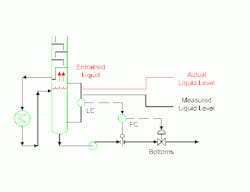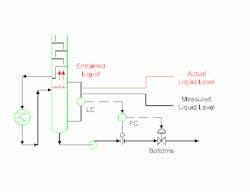Keep measurements on the level
Plants commonly rely on differential pressure (DP) cells to measure level. Readings of the pressure difference between two points, typically in inches of water equivalent — standard ranges include 0 to 20, 0 to 50, 0 to 100, 0 to 200, and 0 to 500 inches — go to the process control system which converts these into liquid levels based on an assumed specific gravity inside the vessel.
However, these levels aren’t always correct. For instance, foam can cause errors because of its lower density than the liquid. This column highlights another problem related to incorrect specific gravity.
A cryogenic field-extraction unit had two possible operating modes. The first was an ethane rejection mode, where ethane was sent overhead. The second was an ethane recovery mode, where the main tower switched to demethanizer operation; here, the overhead product was methane and lighter while the bottoms product was ethane and heavier. The recovered liquid (tower bottoms) was sent to a separate plant that segregated the liquid stream into consumer LPG and petrochemical feeds.
The plant successfully started up in ethane rejection mode and operated for two years. Then, after downstream modifications, the unit shifted to ethane recovery mode. Tower problems immediately occurred. The bottoms liquid would intermittently back into the reboiler return line (Figure 1). Reboiler vapor entering the liquid held in the boot forced the liquid up, flooding the tower. The flooded tower sent liquid overhead, upsetting the heat balance between the overhead vapor and feed cooling, and thus precluding effective control of coldbox heat integration.
Field troubleshooting identified the culprit as changed densities in the tower. The ethane recovery mode had lower liquid densities — leading to “measured” values inside the tower being below the actual liquid levels. Calibrating the liquid level measurement for the new densities immediately corrected the operating problems.
As this example illustrates, it is important to check liquid densities whenever there are any significant changes in streams.
Andrew Sloley, contributing editor

